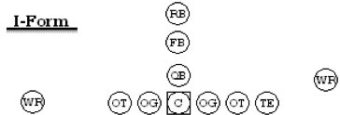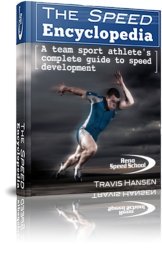Reading Offenses
As a Great Cornerback, your athletic and cornerback-specific skills will get you far. But what will put you head and shoulders above your peers and opponents is your capacity for reading offenses and picking them apart in your head.
Developing this skill can not only increase your awareness, but it allows you to have more control in a game situations.
Knowing Offensive Tendencies
Most four-year college football programs give their players a run-down of what their opponents do in certain down-and-distance situations. Here is an example of what this might look like for a particular team:
Down-and-Distance Tendencies
Down & Distance |
Run% |
Pass% |
Short |
||
1st & Short |
75% |
25% |
2nd & Short* |
30% |
70% |
3rd & Short |
55% |
45% |
4th & Short |
6% |
6% |
Medium |
||
1st Med |
60% |
40% |
2nd & Med |
55% |
45% |
3rd & Med |
35% |
65% |
4th & Med |
3% |
4% |
Long |
||
1st Long |
45% |
55% |
2nd & Long |
40% |
60% |
3rd & Long |
20% |
80% |
4th & Long |
2% |
4% |
*Because a team still has 3rd down to get the short yards, they will sometimes use the 2nd and short situation to go for a big play, so watch out!
Field Position Tendencies
Another dimension to knowing offenses is to analyze them based on their field position. So you'll not only know their down-and-distance tendencies, but also their tendencies for each zone of the field.
For example:
Down &Distance |
Own Red Endzone-20 |
Own Orange 20-40 |
Midfield 40-40 |
Orange 40-20 |
Red Zone 20-Endzone |
||||||
Run% |
Pass% |
Run% |
Pass% |
Run% |
Pass% |
Run% |
Pass% |
Run% |
Pass% |
||
Short (1-4yds) |
|||||||||||
1st & Short |
70% |
30% |
65% |
35% |
65% |
35% |
60% |
40% |
65% |
35% |
|
2nd & Short |
60% |
40% |
30% |
70% |
55% |
45% |
30% |
70% |
40% |
60% |
|
3rd & Short |
55% |
45% |
45% |
55% |
40% |
60% |
45% |
55% |
75% |
25% |
|
4th & Short |
8% |
4 % |
6% |
4% |
6% |
8% |
10% |
5% |
5% |
4% |
|
Medium (5-7yds) |
|||||||||||
1st Med |
30% |
70% |
65% |
35% |
45% |
55% |
60% |
40% |
45% |
55% |
|
2nd & Med |
55% |
45% |
45% |
55% |
55% |
45% |
65% |
35% |
55% |
45% |
|
3rd & Med |
40% |
60% |
33% |
66% |
33% |
66% |
35% |
65% |
60% |
40% |
|
4th & Med |
5% |
2% |
5% |
3% |
3% |
6% |
3% |
2% |
4% |
3% |
|
Long (7+yds) |
|||||||||||
1st & Long |
60% |
40% |
70% |
30% |
40% |
60% |
70% |
30% |
60% |
40% |
|
2nd & Long |
60% |
40% |
45% |
55% |
55% |
45% |
0% |
100% |
55% |
45% |
|
3rd & Long |
25% |
75% |
30% |
70% |
20% |
80% |
0% |
100% |
25% |
75% |
|
4th & Long |
2% |
4% |
3% |
5% |
4% |
6% |
15% |
8% |
3% |
4% |
|
Goal (1-10yds) |
|||||||||||
1st and G |
N/A |
N/A |
N/A |
N/A |
85% |
15% |
|||||
2nd and G |
N/A |
N/A |
N/A |
N/A |
80% |
20% |
|||||
3rd and G |
N/A |
N/A |
N/A |
N/A |
70% |
30% |
|||||
4th and G |
N/A |
N/A |
N/A |
N/A |
5% |
5% |
|||||
Anybody can create (and study) these charts on any team by watching film on them and recording what they do. (Actually, you can copy and paste this table if you want. Just clear the table and fill it in with your opponent's info).
How to use this chart
You're probably asking yourself, "Do I have to remember that whole chart?", and the answer is no.
You want to look at places where there are definite patterns and use those patterns to read your opponent.
For example, there are certain situations in which this team's plays are very predictable. Like on 3rd and Long, you can pretty much bet on a pass and--about eight times out of ten--you'll be right!
Of course, it also helps to have more specific info on your opponent than their run/pass tendencies. Knowing what those run/pass plays are gives you more insight into what they might do.
For example, you could fill those run/pass gaps with a tailback sweep or a post to the X wideout.
(Besides, you don't want to rely solely on tendencies because some offensive coordinators deliberately change them up to throw their opponents off.)
Reading Offensive Formations
When reading plays, it also helps to know formations, because certain formations are geared for either run or pass plays. Here are some basic formations you may see in a game, their purpose, and what you should do when you see them.
A reminder: as a defensive back, your
primary job is to stop the pass. So as I go through these formations, keep
in mind that you are looking for ways teams might throw out of them.
3-Back Set
The 3-back set is rare nowadays. The two most popular 3-back formations are the wishbone and the wing-t. You don't really see this in the pros or college, but some high schools still run these formations, so I will explain them.
They are obviously geared toward the run, especially the wishbone, which puts a tailback behind two larger backs for added blocking.
Another advantage of these formations is the added pass protection, which gives the QB more time in the pocket, and means more cover time for the defensive secondary.
The wing-t relies heavily on misdirections, QB bootlegs, and traps to move the ball. So for the most part, you will have outside containment responsibilities on the run. In some of these situations, the cornerback on the play side will have to take on pulling guards to force the play inside, which is called playing the "force" corner.


When playing against the 3-back set, or any set for that matter, defensive backs are always looking for ways in which the team may throw out of it. In Wing-T 2, the receivers are spread out, so while the formation is obviously geared toward running, it is still suitable for an air attack.
In 3-back sets, there are a only two receivers/tight ends that are eligible to catch the ball (not including the backs, who can catch out of the backfield), so defensive backs won't have to read much.
In this case, most coaches go with more size and put more beef in the box, leaving cornerbacks one-on-one with wide receivers/tight ends in man, or playing force on run plays in Cover 2.
2-Back Set
The two-back set is also geared more toward the run. In two-back sets, though, there are three possible eligible receivers which lends more to passing.


Most often called the "pro" set when the backs are split apart, and "I"-formation when backs line up one behind the other, two-back sets give offenses a more balanced attack, more so at us when they spread their receivers out.

The pro set is the most commonly used two-back set in football. When teams need the hard yards, though, they will put a tailback behind a fullback in an "i" formation to open up some holes.

In many sets where the receivers are lined up 2-by-1 (2 on one side and 1 wide out on the the other) the wide out on the weak side is most likely the other team's go-to guy. They like to match their best guy 1-on-1 out in space with a defensive back.
For some strange reason, they think its an advantage.
1-Back Set (Spread)
The 1-back set is where we make our money. With four eligible receivers the stakes climb, because now there are more receivers for the QB to hit. Depending on the offensive personnel and formation, coaches will have to change defensive personnel to react.

The Shotgun Offense
In this set, many teams run the "shotgun", where the quarterback is no longer under the center, but takes the snap from about 3-4yds behind the line of schrimmage.
The lone running back acts as a pass blocker for the most part, but can also be used to run a screen or a draw, or as a last-second option if the play breaks down.
This gives the QB a little more space to work with and more time to read the defense. (See Reading Quarterbacks for more info on how to read the qb in shotgun.)
In the situation where there are 4 spread receivers on the field, most defensive coordinators will call in their nickel package, or five defensive backs, in order to match the match the threat of four receivers.
Empty-Set
The empty set, also called "five wide" when all receivers are spread, is totally geared toward passing, except when the QB decides to run. This formation is very dangerous when you're dealing with a highly mobile QB because the spread defense, with 5-6 players in the box, gives him more room to maneuver.

When it comes to covering the receivers, most defensive coaches will likely call in their dime package, which consists of six defensive backs: one to two safeties, and four to five cornerbacks, depending on the ability of the safeties to cover.
The number of linebackers also shifts, depending on the tight ends in the game. This is obviously to handle the greater threat of a passing attack.
Offenses in spread and empty formations really like to do a lot of crossing patterns and pick routes. Like a screen in basketball, receivers will cross with each other in to in your way, which helps the receivers get open easier.
In most situations like this, coaches will have their defensive backs play a teamwork system where each defensive back takes the receiver that breaks in their direction.
Sometimes though, you still might have to stay on your receiver, regardless of the pick.
So, if your receiver is on the line of scrimmage and is bunched up with other receivers, its best to press him on the line in man coverage. (If you get a good jam, you take away his ability to cross with the other receivers, and throw the timing of the route off.)
So, there are several ways you can read offenses:
- Read their down-and-distance tendencies
- Read their field position tendencies
Armed with this information, you should be reading offenses and breaking down every opponent like you know their playbook.
Use this information to impose your will, and
dominate.













New! Comments
Have your say about what you just read! Leave me a comment in the box below.